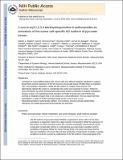| dc.contributor.author | Walsh, Martin J. | |
| dc.contributor.author | Brimacombe, Kyle R. | |
| dc.contributor.author | Veith, Henrike | |
| dc.contributor.author | Bougie, James M. | |
| dc.contributor.author | Daniel, Thomas | |
| dc.contributor.author | Leister, William | |
| dc.contributor.author | Cantley, Lewis C. | |
| dc.contributor.author | Vander Heiden, Matthew G. | |
| dc.contributor.author | Shen, Min | |
| dc.contributor.author | Auld, Douglas S. | |
| dc.contributor.author | Thomas, Craig J. | |
| dc.contributor.author | Boxer, Matthew B. | |
| dc.contributor.author | Israelsen, William James | |
| dc.date.accessioned | 2015-10-07T15:04:46Z | |
| dc.date.available | 2015-10-07T15:04:46Z | |
| dc.date.issued | 2011-09 | |
| dc.date.submitted | 2011-08 | |
| dc.identifier.issn | 0960894X | |
| dc.identifier.uri | http://hdl.handle.net/1721.1/99178 | |
| dc.description.abstract | Compared to normal differentiated cells, cancer cells have altered metabolic regulation to support biosynthesis and the expression of the M2 isozyme of pyruvate kinase (PKM2) plays an important role in this anabolic metabolism. While the M1 isoform is a highly active enzyme, the alternatively spliced M2 variant is considerably less active and expressed in tumors. While the exact mechanism by which decreased pyruvate kinase activity contributes to anabolic metabolism remains unclear, it is hypothesized that activation of PKM2 to levels seen with PKM1 may promote a metabolic program that is not conducive to cell proliferation. Here we report the third chemotype in a series of PKM2 activators based on the 2-oxo-N-aryl-1,2,3,4-tetrahydroquinoline-6-sulfonamide scaffold. The synthesis, structure activity relationships, selectivity and notable physiochemical properties are described. | en_US |
| dc.description.sponsorship | National Human Genome Research Institute (U.S.) (Molecular Libraries Initiative of the NIH Roadmap for Medical Research) | en_US |
| dc.language.iso | en_US | |
| dc.publisher | Elsevier | en_US |
| dc.relation.isversionof | http://dx.doi.org/10.1016/j.bmcl.2011.08.114 | en_US |
| dc.rights | Creative Commons Attribution-Noncommercial-NoDerivatives | en_US |
| dc.rights.uri | http://creativecommons.org/licenses/by-nc-nd/4.0/ | en_US |
| dc.source | PMC | en_US |
| dc.title | 2-Oxo-N-aryl-1,2,3,4-tetrahydroquinoline-6-sulfonamides as activators of the tumor cell specific M2 isoform of pyruvate kinase | en_US |
| dc.type | Article | en_US |
| dc.identifier.citation | Walsh, Martin J., Kyle R. Brimacombe, Henrike Veith, James M. Bougie, Thomas Daniel, William Leister, Lewis C. Cantley, et al. “2-Oxo-N-Aryl-1,2,3,4-Tetrahydroquinoline-6-Sulfonamides as Activators of the Tumor Cell Specific M2 Isoform of Pyruvate Kinase.” Bioorganic & Medicinal Chemistry Letters 21, no. 21 (November 2011): 6322–6327. | en_US |
| dc.contributor.department | Massachusetts Institute of Technology. Department of Biology | en_US |
| dc.contributor.department | Koch Institute for Integrative Cancer Research at MIT | en_US |
| dc.contributor.mitauthor | Israelsen, William J. | en_US |
| dc.contributor.mitauthor | Vander Heiden, Matthew G. | en_US |
| dc.relation.journal | Bioorganic & Medicinal Chemistry Letters | en_US |
| dc.eprint.version | Author's final manuscript | en_US |
| dc.type.uri | http://purl.org/eprint/type/JournalArticle | en_US |
| eprint.status | http://purl.org/eprint/status/PeerReviewed | en_US |
| dspace.orderedauthors | Walsh, Martin J.; Brimacombe, Kyle R.; Veith, Henrike; Bougie, James M.; Daniel, Thomas; Leister, William; Cantley, Lewis C.; Israelsen, William J.; Vander Heiden, Matthew G.; Shen, Min; Auld, Douglas S.; Thomas, Craig J.; Boxer, Matthew B. | en_US |
| dc.identifier.orcid | https://orcid.org/0000-0002-6702-4192 | |
| mit.license | PUBLISHER_CC | en_US |
| mit.metadata.status | Complete | |
